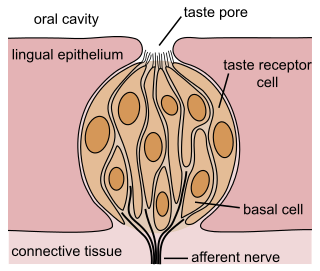External links
- Dr. Tordoff's page at the Monell Chemical Senses Center website
- The Elsevier Science Direct Directory of the works of Dr. Tordoff
Michael Tordoff | |
|---|---|
| Born | 1956 Bradford, Yorkshire, UK |
| Alma mater | UCLA |
| Known for | Work on calcium intake and appetite |
| Scientific career | |
| Fields | Biology, Genetics |
| Institutions | Monell Chemical Senses Center |
Dr. Michael G. Tordoff is a psychobiologist who worked at the Monell Chemical Senses Center. His research deals with the genetics and physiology of taste and nutrition. His early work addressed (a) how and what animals learn about the value of their food, [1] (b) how artificial sweeteners influence appetite and body weight, [2] (c) how salt intake is regulated, and (d) how dietary calcium influences salt intake. [3] Recently, he has been investigating calcium taste and appetite. [4] [5] He is the primary proponent of the notion that calcium is a basic taste, equivalent to sweet, sour, salty, and bitter.
Dr. Tordoff hosts the Monell Mouse Taste Phenotyping Project. In August 2009, he bicycled across the USA in 27 days. He is married to, and often collaborates with, Dr. Danielle Reed.

Umami, or savoriness, is one of the five basic tastes. It is characteristic of broths and cooked meats.

Dietary fiber or roughage is the portion of plant-derived food that cannot be completely broken down by human digestive enzymes. Dietary fibers are diverse in chemical composition and can be grouped generally by their solubility, viscosity and fermentability which affect how fibers are processed in the body. Dietary fiber has two main subtypes: soluble fiber and insoluble fiber which are components of plant-based foods such as legumes, whole grains, cereals, vegetables, fruits, and nuts or seeds. A diet high in regular fiber consumption is generally associated with supporting health and lowering the risk of several diseases. Dietary fiber consists of non-starch polysaccharides and other plant components such as cellulose, resistant starch, resistant dextrins, inulins, lignins, chitins, pectins, beta-glucans, and oligosaccharides.

In the context of nutrition, a mineral is a chemical element. Some "minerals" are essential for life, but most are not. Minerals are one of the four groups of essential nutrients; the others are vitamins, essential fatty acids, and essential amino acids. The five major minerals in the human body are calcium, phosphorus, potassium, sodium, and magnesium. The remaining minerals are called "trace elements". The generally accepted trace elements are iron, chlorine, cobalt, copper, zinc, manganese, molybdenum, iodine, selenium, and bromine; there is some evidence that there may be more.
Supertasters are individuals whose sense of taste for certain flavors and foods, such as chocolate, is far more sensitive than the average person. The term originated with experimental psychologist Linda Bartoshuk and is not the result of response bias or a scaling artifact but appears to have an anatomical or biological basis.

Enterostatin is a pentapeptide derived from a proenzyme in the gastrointestinal tract called procolipase. It reduces food intake, in particular fat intake, when given peripherally or into the brain.

The Monell Chemical Senses Center is an independent, non-profit scientific research institute located at the University City Science Center campus in Philadelphia. Founded in 1968, it is dedicated to interdisciplinary basic research on the senses of taste and smell. The center's mission is to improve health and well-being by advancing the scientific understanding of taste, smell, and related senses. Monell's research focuses on various aspects of chemosensory science, including how chemical senses affect human health, behavior, and the environment. The center employs a collaborative and interdisciplinary approach, with scientists from diverse fields such as sensory psychology, biophysics, chemistry, behavioral neuroscience, environmental science, and genetics working together on research projects.

A taste receptor or tastant is a type of cellular receptor that facilitates the sensation of taste. When food or other substances enter the mouth, molecules interact with saliva and are bound to taste receptors in the oral cavity and other locations. Molecules which give a sensation of taste are considered "sapid".

Taste receptor 2 member 38 is a protein that in humans is encoded by the TAS2R38 gene. TAS2R38 is a bitter taste receptor; varying genotypes of TAS2R38 influence the ability to taste both 6-n-propylthiouracil (PROP) and phenylthiocarbamide (PTC). Though it has often been proposed that varying taste receptor genotypes could influence tasting ability, TAS2R38 is one of the few taste receptors shown to have this function.

Palatability is the hedonic reward provided by foods or drinks that are agreeable to the "palate", which often varies relative to the homeostatic satisfaction of nutritional and/or water needs. The palatability of a dish or beverage, unlike its flavor or taste, varies with the state of an individual: it is lower after consumption and higher when deprived. It has increasingly been appreciated that this can create a hunger that is independent of homeostatic needs.
Danielle Renee Reed is an American geneticist employed at the Monell Chemical Senses Center in Philadelphia, Pennsylvania. She is most notable for her papers regarding genetic variation in taste and obesity in mice and humans.
Dr. Gary K. Beauchamp was the director and president of the Monell Chemical Senses Center from August 1990 to September 2014.
Dr. Alexander Bachmanov studied veterinary medicine at the Saint Petersburg Veterinary Institute, Russia (1977-1982), received his Ph.D. in biological sciences from the Pavlov Institute of Physiology in Saint Petersburg, Russia in 1990. He completed postdoctoral fellowships at the Physiological Laboratory at Cambridge University in 1993 and at the Monell Chemical Senses Center, Philadelphia, Pennsylvania, in the United States from 1994 to 1997. He later joined Monnell's faculty.
George Preti was an analytical organic chemist who worked at the Monell Chemical Senses Center in Philadelphia, Pennsylvania. For more than four decades, his research focused on the nature, origin, and functional significance of human odors. Dr. Preti's laboratory has identified characteristic underarm odorants, and his later studies centered upon a bioassay-guided approach to the identification of human pheromones, odors diagnostic of human disease, human malodor identification and suppression and examining the “odor-print” of humans.
Dr. Morley Richard Kare (1922–1990) was a physiologist and biologist.

Devazepide is benzodiazepine drug, but with quite different actions from most benzodiazepines, lacking affinity for GABAA receptors and instead acting as an CCKA receptor antagonist. It increases appetite and accelerates gastric emptying, and has been suggested as a potential treatment for a variety of gastrointestinal problems including dyspepsia, gastroparesis and gastric reflux. It is also widely used in scientific research into the CCKA receptor.

The gustatory system or sense of taste is the sensory system that is partially responsible for the perception of taste (flavor). Taste is the perception stimulated when a substance in the mouth reacts chemically with taste receptor cells located on taste buds in the oral cavity, mostly on the tongue. Taste, along with the sense of smell and trigeminal nerve stimulation, determines flavors of food and other substances. Humans have taste receptors on taste buds and other areas, including the upper surface of the tongue and the epiglottis. The gustatory cortex is responsible for the perception of taste.
Specific appetite, also known as specific hunger, is a drive to eat foods with specific flavors or other characteristics.

Weight management refers to behaviors, techniques, and physiological processes that contribute to a person's ability to attain and maintain a healthy weight. Most weight management techniques encompass long-term lifestyle strategies that promote healthy eating and daily physical activity. Moreover, weight management involves developing meaningful ways to track weight over time and to identify the ideal body weights for different individuals.
Satiety value is the degree at which food gives a human the sense of food gratification, the exact contrast feeling of hunger. The concept of the Satiety Value and Satiety Index was developed by Australian researcher and doctor, Susanna Holt. Highest satiety value is expected when the food that remains in the stomach for a longer period produces greatest functional activity of the organ. Limiting the food intake after reaching the satiety value helps reduce obesity problems.
Hedonic hunger or hedonic hyperphagia is the "drive to eat to obtain pleasure in the absence of an energy deficit". Particular foods may have a high "hedonic rating" or individuals may have increased susceptibility to environmental food cues. Weight loss programs may aim to control or to compensate for hedonic hunger. Therapeutic interventions may influence hedonic eating behavior.